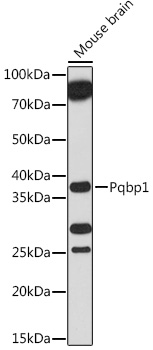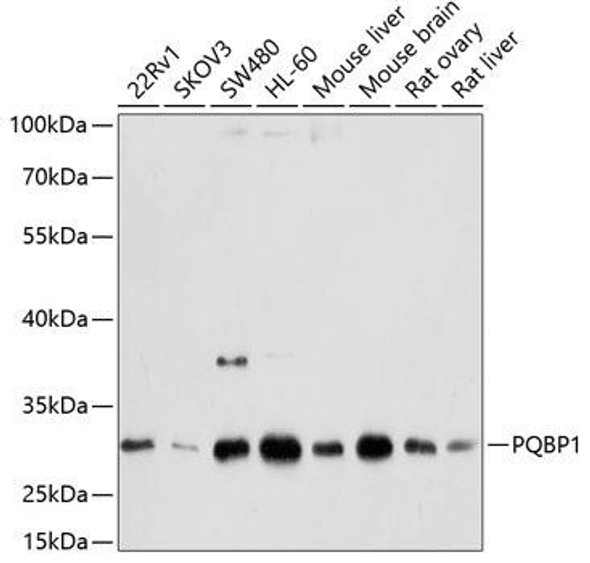Cell Biology Antibodies 15
Anti-Pqbp1 Antibody (CAB18680)
- SKU:
- CAB18680
- Product Type:
- Antibody
- Reactivity:
- Human
- Reactivity:
- Mouse
- Reactivity:
- Rat
- Host Species:
- Rabbit
- Isotype:
- IgG
- Research Area:
- Cell Biology
Description
| Antibody Name: | Anti-Pqbp1 Antibody |
| Antibody SKU: | CAB18680 |
| Antibody Size: | 20uL, 50uL, 100uL |
| Application: | WB |
| Reactivity: | Human, Mouse, Rat |
| Host Species: | Rabbit |
| Immunogen: | Recombinant protein of Mouse Pqbp1. |
| Application: | WB |
| Recommended Dilution: | WB 1:500 - 1:2000 |
| Reactivity: | Human, Mouse, Rat |
| Positive Samples: | Mouse brain, Rat brain |
| Immunogen: | Recombinant protein of Mouse Pqbp1. |
| Purification Method: | Affinity purification |
| Storage Buffer: | Store at -20°C. Avoid freeze / thaw cycles. Buffer: PBS with 0.02% sodium azide, 50% glycerol, pH7.3. |
| Isotype: | IgG |
| Sequence: | Email for sequence |
| Gene ID: | 54633 |
| Uniprot: | Q91VJ5 |
| Cellular Location: | |
| Calculated MW: | |
| Observed MW: | 35kDa |
| Synonyms: | |
| Background: |
| UniProt Protein Function: | PQBP1: May suppress the ability of POU3F2 to transactivate the DRD1 gene in a POU3F2 dependent manner. Can activate transcription directly or via association with the transcription machinery. May be involved in ATXN1 mutant-induced cell death. The interaction with ATXN1 mutant reduces levels of phosphorylated RNA polymerase II large subunit. Defects in PQBP1 are the cause of Renpenning syndrome 1 (RENS1); also known as Sutherland-Haan X-linked mental retardation syndrome (SHS) or X-linked mental retardation syndromes MRXS3/MRXS8/MRX55. The clinical features are mental retardation, microcephaly, short stature, and small testes. The craniofacies tends to be narrow and tall with upslanting palpebral fissures, abnormal nasal configuration, cupped ears, and short philtrum. The nose may appear long or bulbous, with overhanging columella. Less consistent manifestations include ocular colobomas, cardiac malformations, cleft palate, and anal anomalies. RENS1 is more frequently in males than in females where little or no expression is found. 10 isoforms of the human protein are produced by alternative splicing. |
| UniProt Protein Details: | Protein type:Transcription, coactivator/corepressor Cellular Component: nucleoplasm; centrosome; stress granule; cytoplasm; nuclear speck; nucleus Molecular Function:protein C-terminus binding; ribonucleoprotein binding Biological Process: alternative nuclear mRNA splicing, via spliceosome; stress granule assembly; regulation of transcription, DNA-dependent; transcription, DNA-dependent; regulation of RNA splicing; regulation of dendrite morphogenesis; RNA splicing; mRNA processing; neurite development |
| UniProt Code: | Q91VJ5 |
| NCBI GenInfo Identifier: | 11125356 |
| NCBI Gene ID: | 54633 |
| NCBI Accession: | CAC15062.1 |
| UniProt Secondary Accession: | Q91VJ5,Q80WW2, Q9ER43, Q9QYY2, |
| UniProt Related Accession: | Q91VJ5 |
| Molecular Weight: | 30,597 Da |
| NCBI Full Name: | polyglutamine tract binding protein-1 |
| NCBI Synonym Full Names: | polyglutamine binding protein 1 |
| NCBI Official Symbol: | Pqbp1 |
| NCBI Official Synonym Symbols: | Sfc2; npw38; PQBP-1 |
| NCBI Protein Information: | polyglutamine-binding protein 1; scurfy candidate 2; polyglutamine tract-binding protein 1; 38 kDa nuclear protein containing a WW domain |
| UniProt Protein Name: | Polyglutamine-binding protein 1 |
| UniProt Synonym Protein Names: | 38 kDa nuclear protein containing a WW domain; Npw38; Polyglutamine tract-binding protein 1 |
| Protein Family: | Polyglutamine-repeat protein |
| UniProt Gene Name: | Pqbp1 |
| UniProt Entry Name: | PQBP1_MOUSE |







